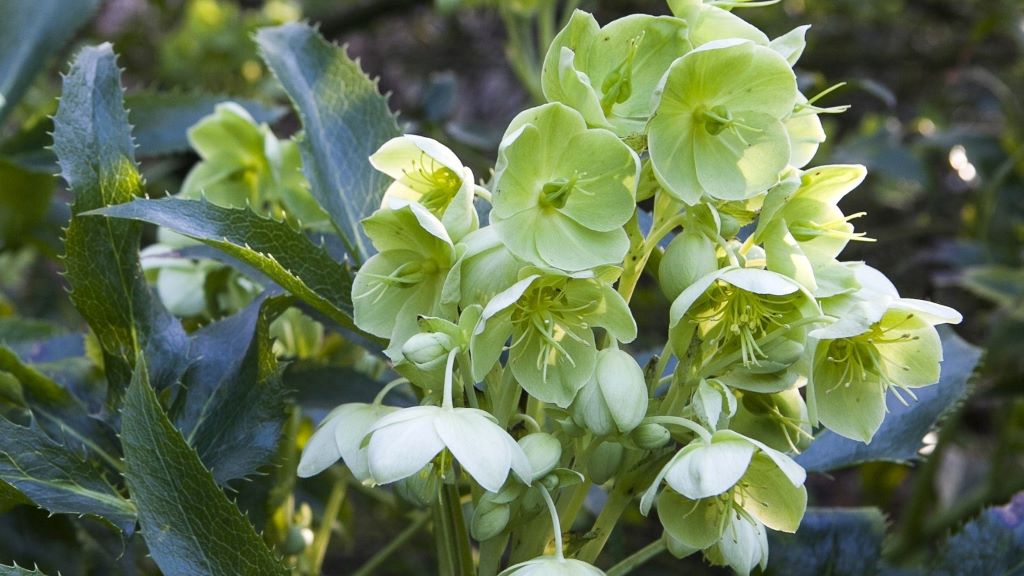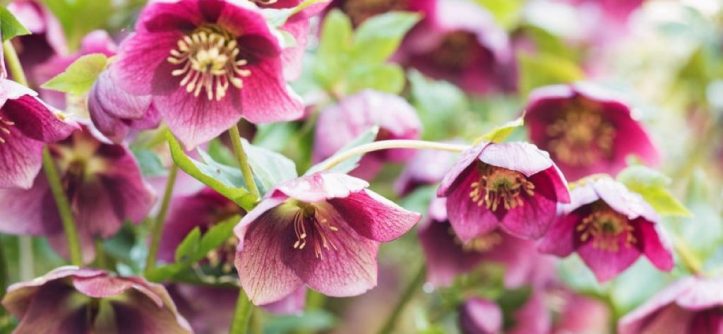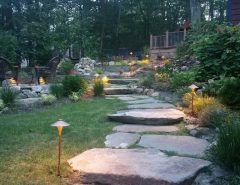The first brave bloom of the year, often pushing through a crust of snow, is a moment of pure magic in the garden. Hellebores, aptly named the Christmas or Lenten Rose, are the undisputed royalty of the late winter and early spring border. Their elegant, downward-facing flowers in shades of white, pink, plum, and near-black provide a lifeline for early pollinators and hope for the winter-weary gardener.
But then, summer arrives. The showy bracts (what we often call petals) fade, the lush foliage starts to look a little tired, and your hellebores are overshadowed by the bright, brash colors of peonies, roses, and daylilies. It’s at this precise moment that many gardeners make a critical mistake: they forget about them.
What you do with your hellebores in summer doesn’t just affect them now; it sets the stage for next year’s spectacular performance. Summer is not a period of dormancy for these plants, but a season of crucial preparation. This is when they quietly develop the flower buds for the following winter. Neglect them now, and you risk a disappointing, sparse display when you need their cheer the most.
This ultimate guide will walk you through every essential task, from strategic pruning and vigilant pest control to optimal feeding and watering, ensuring your hellebores remain healthy, vibrant, and ready to put on their best show yet.
Understanding the Hellebore’s Summer Life Cycle
To care for them properly, it helps to know what’s happening beneath the soil and within the plant. After their breathtaking spring display, hellebores don’t shut down. Instead, they enter a period of active growth and resource gathering.
- Energy Production: The existing foliage is a solar panel, photosynthesizing sunlight to create energy.
- Bud Formation: This is the most critical summer activity. Deep within the crown of the plant, the microscopic beginnings of next year’s flowers are being formed. This process requires significant resources.
- Root Development: The warm soil encourages root growth, establishing a stronger, more drought-resistant plant for the future.
Your summer care is all about supporting these three vital processes.
Task 1: The Great Hellebore Pruning Debate – To Cut or Not to Cut?
This is the most common question regarding summer hellebore care, and the answer isn’t a simple yes or no. It depends on the health of the foliage and your aesthetic preferences.
The Case FOR Cutting Back Old Foliage:
Hellebore leaves are evergreen but not immortal. Over the season, they can become tattered, develop black spots (from the fungus Coniothyrium hellebori), or simply look unsightly. Removing this damaged foliage serves several purposes:
- Disease Prevention: It drastically reduces the chance of fungal spores overwintering and reinfecting the new growth that emerges later in the season.
- Aesthetic Appeal: It cleans up the plant’s appearance, making the garden bed look neater.
- Reveals New Growth: It allows light and air to reach the base of the plant, encouraging a fresh flush of new, healthy leaves.
How to Prune Correctly:
- Timing: The best time is late spring or early summer, after flowering is completely finished but before the new leaf growth has fully emerged.
- Technique: Using clean, sharp secateurs, cut each leaf stem back as close to the base as possible without damaging the crown. Never pull or tear the leaves away.
- Safety: Wear gloves, as the sap can be irritating to skin for some people.
The Case AGAINST Cutting Back (The “Lazy Gardening” Method):
Many experienced hellebore growers advocate for leaving the old foliage alone. The plant will naturally shed its oldest leaves as new ones grow in. The existing foliage continues to provide energy and offers a protective mulch layer over the plant’s crown through the summer.
Verdict: If your foliage is healthy and green, leaving it is perfectly fine. If it’s spotted, ragged, or you simply prefer a tidier garden, pruning is highly beneficial.
Task 2: Mastering the Watering Balance
Hellebores are celebrated for their drought tolerance once established, but “tolerant” doesn’t mean “invincible.” Summer heat and dry spells can stress the plant, directly impacting the development of those precious future flower buds.
- The Goal: Consistent, moderate moisture. You want the soil to be like a well-wrung-out sponge – moist but never soggy.
- Deep Watering: When you do water, do it deeply and infrequently. A long, slow soak encourages roots to grow deeper into the soil, making the plant more resilient. Light, frequent sprinkling encourages shallow roots that are vulnerable to heat.
- Signs of Stress: Wilting or drooping leaves are a clear cry for help. It’s best to water before this point.
- Mulch is Your Best Friend: A 2-3 inch layer of organic mulch (like shredded bark, compost, or leaf mold) around the base of the plant is absolutely crucial for summer care. It conserves soil moisture, keeps roots cool, suppresses weeds, and breaks down to feed the soil.
Task 3: The Summer Feed – A Nutrient Boost for Future Blooms
Since your hellebore is working hard to create next year’s flowers, a light summer feeding can give it a welcome boost.
- Timing: A single application in early summer is sufficient.
- What to Use: A balanced, organic fertilizer is ideal. Options include:
- Compost or well-rotted manure: Gently work a handful into the soil around the plant (being careful not to disturb shallow roots) and cover with mulch.
- A balanced organic granular fertilizer (e.g., 5-5-5).
- A liquid fertilizer like fish emulsion or seaweed extract.
- Less is More: Avoid high-nitrogen fertilizers, which promote excessive leafy growth at the expense of flowers. The goal is a gentle, sustained release of nutrients.
Task 4: Pest and Disease Patrol
Hellebores are largely pest-resistant, thanks to their toxic nature. However, two main issues can pop up in summer:
- Aphids: These sap-sucking insects can occasionally cluster on new growth and flower buds. A strong blast of water from the hose is often enough to dislodge them. For persistent problems, use an insecticidal soap.
- Leaf Spot: The aforementioned fungal disease causing black or brown spots. The best control is prevention through good air circulation and pruning affected leaves. Avoid overhead watering which wets the foliage.

Task 5: Division and Propagation (If Needed)
Summer is not the ideal time for division (early spring is better), but if a plant is overgrown or you must move it, you can do so with care.
- Water the plant thoroughly the day before you plan to divide.
- Dig up the entire clump and use a sharp, clean spade or knife to cut it into smaller sections, each with at least two or three growing buds (eyes).
- Replant immediately at the same soil depth they were growing before and water deeply. Keep them well-watered for the rest of the season as they re-establish.
Designing With Summer Hellebores
A hellebore’s large, textural, palmate leaves are a valuable asset in the summer shade garden even after the flowers are gone. Use them as a backdrop for other plants.
- Fantastic Companions: Plant them alongside hostas, ferns, astilbes, and hardy geraniums. The hellebore foliage provides a beautiful green canvas that makes the flowers of other plants pop.
- Seeding Consideration: Helleboes readily self-seed. If you don’t want seedlings (which often won’t be true to the parent plant), deadhead spent flower stems before the seed pods dry and split. If you want to encourage naturalization, let them be!
The Hellebore Summer Checklist: At a Glance
- Early Summer: Prune away old, damaged, or diseased foliage.
- All Summer: Maintain a 2-3 inch layer of organic mulch.
- All Summer: Water deeply during extended dry periods.
- Early Summer: Apply a light feed of balanced, organic fertilizer.
- Ongoing: Monitor for aphids and treat if necessary.
- Enjoy! Appreciate the architectural beauty of their foliage in the summer border.
Conclusion: From Summer Prep to Winter Glory
Caring for hellebores in summer is a testament to the gardener’s foresight. It’s an investment in the future, a quiet act of stewardship that pays dividends when the garden is at its bleakest. By providing a little thoughtful attention during these warmer months—judicious pruning, consistent moisture, a light feed, and a watchful eye—you are directly contributing to the vitality and floral abundance of your plants for seasons to come.
Read More:





Leave a Reply